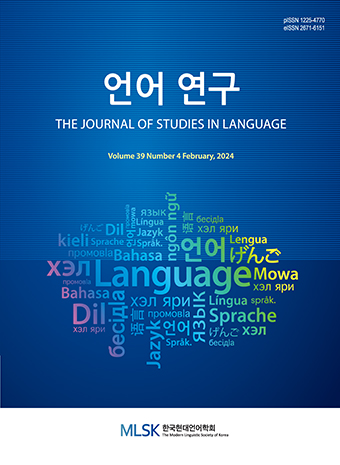Abstract
References
Information
Conversational speech has received considerable attention in recent years, but many instrumental studies have focused on heavily resourced languages and the phonetic reduction in conversation. In order to diversify and expand on conversational speech research, this study examines the unique system of stop contrast in Korean and the acoustic cues in spontaneous phone conversations. The study investigates some key acoustic properties of intervocalic Korean stops in casual speech, adding to the growing body of research on conversational speech. Korean stops from careful reading and casual conversation show greater acoustic variability in conversation, as previously noted. Despite the phonetic variability in acoustic signals, conversational Korean stops contrast with one another in three acoustic dimensions: intensity difference, VOT, and closure duration, allowing some cues to enhance the stop contrast in conversation. The findings point to manner-specific adjustments in spontaneous Korean stops and suggest that variability in conversational speech yields both phonetic reduction and enhancement.
- Anderson, A., M. Bader, E. Bard, E. Boyle, G. Doherty, S. Garrod, S. Isard, J. Kowtko, J. McAllister, J. Miller, C. Sotillo, H. Thompson, and R. Weinert. 1991. The HCRC Map Task Corpus. Language and Speech 34, 351-366.10.1177/002383099103400404
- Arai, T. 1999. A Case Study of Spontaneous Speech in Japanese, Proceedings of the 14th International Congress of Phonetic Sciences (ICPhS).
- Arai, T., N. Warner, and S. Greenberg. 2007. Analysis of Spontaneous Japanese in a Multi-language Telephone-speech Corpus. Acoustical Science and Technology 28, 46-48.10.1250/ast.28.46
- Bang, H., M. Sonderegger, Y. Kang, M. Clayards, and T. Yoon. 2018. The Emergence, Progress, and Impact of Sound Change in Progress in Seoul Korean: Implications for Mechanisms of Tonogenesis. Journal of Phonetics 66, 120-144.10.1016/j.wocn.2017.09.005
- Barry, W. and B. Andreeva. 2001. Cross-language Similarities and Differences in Spontaneous Speech Patterns. Journal of the International Phonetic Association 31, 51-66.10.1017/S0025100301001050
- Bates, D., M. Mächler, B. Bolker, and S. Walker. 2015. Fitting Linear Mixed-effects Models Using lme4. Journal of Statistical Software 65, 1-48.
- Berry, J. 2009. Tone Space Reduction in Mandarin Chinese. The 157th Meeting of the Acoustical Society of America.10.1121/1.4783753
- Boersma, P. and D. Weenink. 2018. Praat: Doing Phonetics by Computer, version 6.0.37. (http://www.praat.org)
- Brenner, D. 2015. The Phonetics of Mandarin Tones in Conversation. Ph.D Dissertation, University of Arizona.
- Cheng, C. 2012. Mechanism of Extreme Phonetic Reduction: Evidence from Taiwan Mandarin. PhD Dissertation, University College London.
- Cheng, C. and Y. Xu. 2009. Extreme Reductions: Contraction of Disyllables into Monosyllables in Taiwan Mandarin. Interspeech 2009, 456-459.
- Cheng, C. and Y. Xu. 2013. Articulatory Limit and Extreme Segmental Reduction in Taiwan Mandarin. Journal of the Acoustical Society of America 134, 4481-4495.10.1121/1.482493025669259
- Cheng, C. and Y. Xu. 2014. Mechanism of Disyllabic Tonal Reduction in Taiwan Mandarin. Language and Speech 58, 281-314.10.1177/0023830914543286 26529898
- Cho, T., S-A. Jun, and P. Ladefoged. 2002. Acoustic and Aerodynamic Correlates of Korean Stops and Fricatives. Journal of Phonetics 30, 193-228.10.1006/jpho.2001.0153
- Ernestus, M. and N. Warner. 2011. An Introduction to Reduced Pronunciation Variants. Journal of Phonetics 39, 253-260.10.1016/S0095-4470(11)00055-6
- Godfrey, J. and E. Holliman. 1993. Switchboard-1 Release 2 LDC97S62. Web Download.
- Johnson, K. 2004. Massive Reduction in Conversational American English. In K. Yoneyama and K. Maekawa (eds.), Spontaneous Speech: Data and Analysis (Proceedings of the 1st Session of the 10th International Symposium), 29-54.
- Kang, K. and S. Guion. 2008. Clear Speech Production of Korean Stops: Changing Phonetic Targets and Enhancement Strategies. Journal of the Acoustical Society of America 124, 3909-3917.10.1121/1.2988292 19206816
- Kang, Y. 2014. Voice Onset Time Merger and Development of Tonal Contrast in Seoul Korean Stops: A Corpus Study. Journal of Phonetics 45, 76-90.10.1016/j.wocn.2014.03.005
- Lee, H. and A. Jongman. 2012. Effects of Tone on the Three-way Laryngeal Distinction in Korean: An Acoustic and Aerodynamic Comparison of the Seoul and South Kyungsang Dialects. Journal of the International Phonetic Association 42, 145-169.10.1017/S0025100312000035
- Lee, H., S. Politzer, and A. Jongman. 2013. Speakers of Tonal and Non-tonal Korean Dialects Use Different Cue Weightings in the Perception of the Three-way Laryngeal Stop Contrast. Journal of Phonetics 41, 117-132.10.1016/j.wocn.2012.12.002
- Lindblom, B. 1990. Explaining Phonetic Variation: A Sketch of the H-H Theory. In W. Hardcastle and A. Marchal (eds.), Speech Production and Speech Modeling. Kluwer Academic Publishers, 403-439.10.1007/978-94-009-2037-8_16
- Lisker, L. and A. Abramson. 1964. A Cross-language Study of Voicing in Initial Stops: Acoustical Measurements. Word 20, 527-565.10.1080/00437956.1964.11659830
- Pitt, M., L. Dilley, K. Johnson, S. Kiesling, W. Raymond, E. Hume, and E. Fosler-Lussier. 2007. Buckeye Corpus of Conversational Speech. 2nd Release.
- R Core Team. 2018. R: A Language and Environment for Statistical Computing. R Foundation for Statistical Computing. Vienna, Austria. (http://www.r-project.org)
- Schertz, J., T. Cho, A. Lotto, and N. Warner. 2015. Individual Differences in Phonetic Cue Use in Production and Perception of a Non-native Sound Contrast. Journal of Phonetics 52, 183-204.10.1016/j.wocn.2015.07.003 26644630 PMC4669969
- Warner, N. 2011. Reduction. In M. van Oostendorp, C. Ewen, E. Hume, and K. Rice (eds.), The Blackwell Companion to Phonology. Oxford: Wiley-Blackwell, 1866-1891.10.1002/9781444335262.wbctp0079
- Warner, N. and B. V. Tucker. 2010. “Pro
b ably, OK , Whatever!”: Variability in Conversational Speech Stops and Flaps. The 159th Meeting of the Acoustical Society of America. - Warner, N. and B. V. Tucker. 2011. Phonetic Variability of Stops and Flaps in Spontaneous and Careful Speech. Journal of the Acoustical Society of America 130, 1606-1617.10.1121/1.3621306 21895098
- Publisher :The Modern Linguistic Society of Korea
- Publisher(Ko) :한국현대언어학회
- Journal Title :The Journal of Studies in Language
- Journal Title(Ko) :언어연구
- Volume : 34
- No :4
- Pages :649-660
- DOI :https://doi.org/10.18627/jslg.34.4.201902.649




 The Journal of Studies in Language
The Journal of Studies in Language






